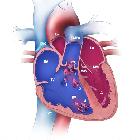ascending aorta dilatation

Imaging of
Marfans syndrome. CT-Aortography showing annuloaortic ectasia with effacement of sinotubular junction with aortic root dilatation.
Dilatation of the ascending aorta is a common finding in the elderly but unusual in younger patients.
Pathology
In adults, an ascending aortic diameter greater than 4 cm is considered to indicate dilatation . Aneurysmal dilatation is considered when the ascending aortic diameter reaches or exceeds 1.5 times the expected normal diameter (equal to or greater than 5 cm).
Etiology
Causes include :
- senile / atherosclerotic ectasia / hypertension
- aneurysm of the ascending aorta
- aortic dissection (Stanford type A / DeBakey type I and II)
- aortic valve
- aortic valve stenosis
- subvalvular aortic stenosis
- aortic valve regurgitation
- bicuspid aortic valve
- coarctation of the aorta
- patent ductus arteriosus
- aortitis
- Kawasaki disease (mild aortic root dilatation is common )
- syphilis
- congenital heart disease
- tetralogy of Fallot
- truncus arteriosus
- pseudotruncus arteriosus
- VSD with right-to-left shunt
- tricuspid atresia with transposition of great arteries
- connective tissue disorders
Siehe auch:
- Osteogenesis imperfecta
- Aortenisthmusstenose
- Persistierender Ductus arteriosus
- Ehlers-Danlos syndrome
- Herzfehler
- Marfan-Syndrom
- Fallot'sche Tetralogie
- Aortenklappenstenose
- Aneurysma Aorta ascendens
- Aortendissektion
- Arterielle Hypertonie
- Ventrikelseptumdefekt
- Truncus arteriosus communis
- DeBakey type I & II
- Stanford type A: A affects ascending aorta and arch
und weiter:

 Assoziationen und Differentialdiagnosen zu Ektasie Aorta ascendens:
Assoziationen und Differentialdiagnosen zu Ektasie Aorta ascendens:










